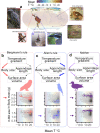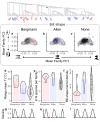Complementarity in Allen's and Bergmann's rules among birds
- PMID: 37454097
- PMCID: PMC10349823
- DOI: 10.1038/s41467-023-39954-9
Complementarity in Allen's and Bergmann's rules among birds
Abstract
Biologists have long noted that endotherms tend to have larger bodies (Bergmann's rule) and shorter appendages (Allen's rule) in colder environments. Nevertheless, many taxonomic groups appear not to conform to these 'rules', and general explanations for these frequent exceptions are currently lacking. Here we note that by combining complementary changes in body and extremity size, lineages could theoretically respond to thermal gradients with smaller changes in either trait than those predicted by either Bergmann's or Allen's rule alone. To test this idea, we leverage geographic, ecological, phylogenetic, and morphological data on 6,974 non-migratory terrestrial bird species, and show that stronger family-wide changes in bill size over thermal gradients are correlated with more muted changes in body size. Additionally, we show that most bird families exhibit weak but appropriately directed changes in both traits, supporting the notion of complementarity in Bergmann's and Allen's rules. Finally, we show that the few families that exhibit significant gradients in either bill or body size, tend to be more speciose, widely distributed, or ecologically constrained. Our findings validate Bergmann's and Allen's logic and remind us that body and bill size are simply convenient proxies for their true quantity of interest: the surface-to-volume ratio.
© 2023. The Author(s).
Conflict of interest statement
The authors declare no competing interests.
Figures




References
-
- Bergmann C. Über die verhältnisse der wärmeökonomie der thiere zu ihrer größe. Göttinger Stud. 1847;1:595–708.
-
- Allen JA. The influence of physical conditions in the genesis of species. Radic. Rev. 1877;1:108–140.
-
- Blackburn TM, Gaston KJ. Spatial patterns in the body sizes of bird species in the new world. Oikos. 1996;77:436–446. doi: 10.2307/3545933. - DOI
-
- Ashton KG. Patterns of within-species body size variation of birds: strong evidence for Bergmann’s rule. Glob. Ecol. Biogeogr. 2002;11:505–523. doi: 10.1046/j.1466-822X.2002.00313.x. - DOI
Publication types
MeSH terms
LinkOut - more resources
Full Text Sources

